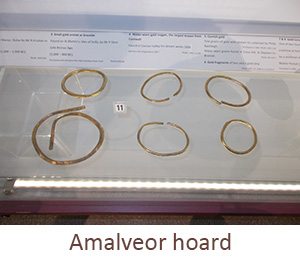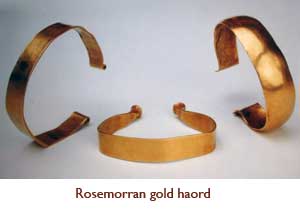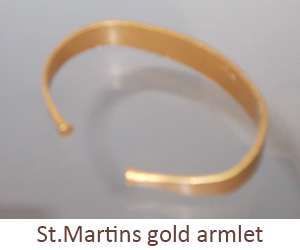Golden treasures from Cornwall's past
by Cheryl Straffon
Closeby to Morvah in West Penwith a minor road leads towards the Mên-an-Tol. Partway along this twisty road is a track that you might walk or drive by without a second glance. It leads to Carne Farm, which lies about half a mile north of Chûn Castle and Quoit. Few seekers after Cornwall's prehistoric past stray this way, for, although there was once a small settlement here, there is little to see now. However, it was at this spot in the remains of this settlement (SW4015 3485) that a major find from the Bronze Age was made. A hoard of gold bracelets was discovered here, six large bracelets, three with distinctive trumpet-like ends. One also has engraved geometric designs on it. These bracelets were almost certainly either made in Ireland or made from Irish gold, and made their way, probably through trade in exchange for tin, to Cornwall. They now reside in the British Museum but are a vivid reminder of how relatively well-off Cornwall was in prehistoric times, and what a surprising amount of gold artefacts and treasures have been found here.
 Another similar hoard of gold ornaments was found in December 1931 near Towednack in West Penwith, close to St.Ives. A sunken lane, known locally as Badger's Lane, leads down from Lady Downs onto the road to Amalveor. Here at SW4794 3759, concealed in an ancient stone hedge, was found a collection of beautiful gold objects, including two twisted neckrings, four armrings and two lengths of unfinished gold rod. One necklet consists of a single twisted strand of gold, and the other consists of three strands loosely twisted together. The gold is very fine, and once again probably came from Ireland. Again these ornaments probably date from the late Bronze Age, but how and why both this deposit and the one at Carne were left and never recovered remains a mystery, and is one to which we shall probably never have an answer.
Another similar hoard of gold ornaments was found in December 1931 near Towednack in West Penwith, close to St.Ives. A sunken lane, known locally as Badger's Lane, leads down from Lady Downs onto the road to Amalveor. Here at SW4794 3759, concealed in an ancient stone hedge, was found a collection of beautiful gold objects, including two twisted neckrings, four armrings and two lengths of unfinished gold rod. One necklet consists of a single twisted strand of gold, and the other consists of three strands loosely twisted together. The gold is very fine, and once again probably came from Ireland. Again these ornaments probably date from the late Bronze Age, but how and why both this deposit and the one at Carne were left and never recovered remains a mystery, and is one to which we shall probably never have an answer.
It seems that there was a lively and regular trade in the Bronze Age between Ireland and Cornwall, and also probably Brittany. As well the finds of gold ornaments in Cornwall, a number of gold crescents and bracelets from Ireland have been found in north-western France. It is significant that these finds in Cornwall all lie on or close to what was probably an ancient track across the peninsula from the Hayle estuary and/or St.Ives island to St.Michael's Mount. This track would have crossed the narrow neck of the peninsula, and marked a direct route from Ireland by sea to Brittany to sea. So, these gold hoards may have been the deposits of Bronze Age traders who intended to come back for them and were never able to do so. Or they may have been traded with the native Cornish for tin, vital for the making of Bronze.
Lunula from Harlyn Bay
 Another major find in Cornwall, showing a trading link with other places, are the gold lunulae, very fine neck ornaments (215-222 mm. in diameter). Four of these have been found in Cornwall: one at Gwithian (in 1783), and one at St.Juliot nr. Boscastle (in 1860). Once again they probably came from Ireland. The other two were found at Harlyn Bay nr. Newquay: one also comes from Ireland, but the other has a decoration that matches one found with unfinished pieces in the Côtes du Nord in France.
Another major find in Cornwall, showing a trading link with other places, are the gold lunulae, very fine neck ornaments (215-222 mm. in diameter). Four of these have been found in Cornwall: one at Gwithian (in 1783), and one at St.Juliot nr. Boscastle (in 1860). Once again they probably came from Ireland. The other two were found at Harlyn Bay nr. Newquay: one also comes from Ireland, but the other has a decoration that matches one found with unfinished pieces in the Côtes du Nord in France.
 These Harlyn Bay lunulae, together with a flat axe, were found by a labourer in 1865, in a relatively low cliff (12 m) above Onjohn Cove, a small cove between Harlyn Bay and Cataclews Point (SW8722 7577). They probably date from the early Bronze Age (2300-2000 BCE), and were perhaps deposited as grave goods, as there is a prehistoric burial site nearby. They were clearly too fine for ordinary everday wear, being made out of fragile wafer-thin crescents of gold, and the shape of these lunulae indicates a symbolic meaning. They represent the lunar crescent horns, and may thus have been objects of great ritual and ceremonial significance.
These Harlyn Bay lunulae, together with a flat axe, were found by a labourer in 1865, in a relatively low cliff (12 m) above Onjohn Cove, a small cove between Harlyn Bay and Cataclews Point (SW8722 7577). They probably date from the early Bronze Age (2300-2000 BCE), and were perhaps deposited as grave goods, as there is a prehistoric burial site nearby. They were clearly too fine for ordinary everday wear, being made out of fragile wafer-thin crescents of gold, and the shape of these lunulae indicates a symbolic meaning. They represent the lunar crescent horns, and may thus have been objects of great ritual and ceremonial significance.
Rillaton Gold Cup
 Perhaps the most famous gold object discovered in Cornwall is the magnificent cup made from corrugated sheet gold found in a cist in Rillaton barrow on the edge of Bodmin Moor (SX2603 7191), about a quarter of a mile NNE of the Hurlers stone circles. It was discovered in 1837 together with the skeleton of a man, a bronze dagger, pieces of ivory and glass beads (all now lost).
Perhaps the most famous gold object discovered in Cornwall is the magnificent cup made from corrugated sheet gold found in a cist in Rillaton barrow on the edge of Bodmin Moor (SX2603 7191), about a quarter of a mile NNE of the Hurlers stone circles. It was discovered in 1837 together with the skeleton of a man, a bronze dagger, pieces of ivory and glass beads (all now lost).
This was clearly an important burial, and the gold cup has some similarities with other prestigious handled cups in precious metals found in areas such as Wessex, Brittany and the Rhineland. A legend became attached to the place that told of a Druid who dwelt nearby and who possessed an ever-refreshing gold cup, but this is clearly a relatively recent legend as the burial pre-dates the Celtic Druids by more than a millenium, being from the early Bronze Age. Patricia M. Christie in an essay entitled "Cornwall in the Bronze Age" (Cornish Archaeology, 25. p.96) makes the intriguing suggestion that the cup may be connected to the Aegean, specifically the Mycenean world, and be evidence of contact between the Bronze Age peoples in the two areas.
The story of the cup is an interesting one. After it was discovered it disappeared from public knowledge for many years. Even Hencken, writing his "Archaeology of Cornwall & Scilly" in 1932 did not know of its whereabouts. However it subsequently turned up in King George V's dressing room, where he had been using it to store his collar studs! It now resides safely in the British Museum with a copy in the Royal Cornwall Museum in Truro.
Gold bracelets
Finally, to come up to more recent times, there have been two finds of gold bracelets in the last decade or so in Cornwall, showing that finds of these precious objects from antiquity can still be made.
 The first to be discovered was in the summer of 1987. On Rosemorran Farm near Gulval in West Penwith, farm worker Tony Richards un- earthed what he thought were three old curtain rings inside each other. However these were subsequently proved to be gold bracelets, dating from the middle Bronze Age (1000-600 BCE). The farm owner Barrie Rodda put them up for auction, and they were sold to a mystery buyer for £25,000, though there are replicas in the County Museum in Truro. Once again, their location proved to be not that far from the Towednack hoard, and were clearly precious objects, probably of a ceremonial significance.
The first to be discovered was in the summer of 1987. On Rosemorran Farm near Gulval in West Penwith, farm worker Tony Richards un- earthed what he thought were three old curtain rings inside each other. However these were subsequently proved to be gold bracelets, dating from the middle Bronze Age (1000-600 BCE). The farm owner Barrie Rodda put them up for auction, and they were sold to a mystery buyer for £25,000, though there are replicas in the County Museum in Truro. Once again, their location proved to be not that far from the Towednack hoard, and were clearly precious objects, probably of a ceremonial significance.
 The most recent find has been of another Bronze Age gold bracelet, discovered on a beach on St.Martins in the Isles of Scilly in 1989 by a visitor from Surrey, Peter Dent. Not realising its value or antiquity he kept it for two months before taking it to the British Museum who declared it a relatively rare type of Bronze Age gold bracelet, dating from about 1000 BCE. The original is now in the County Museum in Truro, with a replica in the Museum on St.Marys. It is only 2½ inches in diameter, and so may have been used as a toe ring, or it may have been a ritual offering, perhaps to the Goddess Sillina on Nor-Nour. Interestingly, it too is made of Irish gold, so could have been brought here by seafarers from Ireland and left as a votive offering for a successful voyage.
The most recent find has been of another Bronze Age gold bracelet, discovered on a beach on St.Martins in the Isles of Scilly in 1989 by a visitor from Surrey, Peter Dent. Not realising its value or antiquity he kept it for two months before taking it to the British Museum who declared it a relatively rare type of Bronze Age gold bracelet, dating from about 1000 BCE. The original is now in the County Museum in Truro, with a replica in the Museum on St.Marys. It is only 2½ inches in diameter, and so may have been used as a toe ring, or it may have been a ritual offering, perhaps to the Goddess Sillina on Nor-Nour. Interestingly, it too is made of Irish gold, so could have been brought here by seafarers from Ireland and left as a votive offering for a successful voyage.
It has also been suggested it may perhaps have come from a hoard deposited elsewhere, so if this is the case, the tides may one day wash some more finds up on Scilly. All these finds show that precious gold objects were relatively frequent in the Bronze Age in Cornwall, and that many may still be awaiting chance discoveries - perhaps by you!
